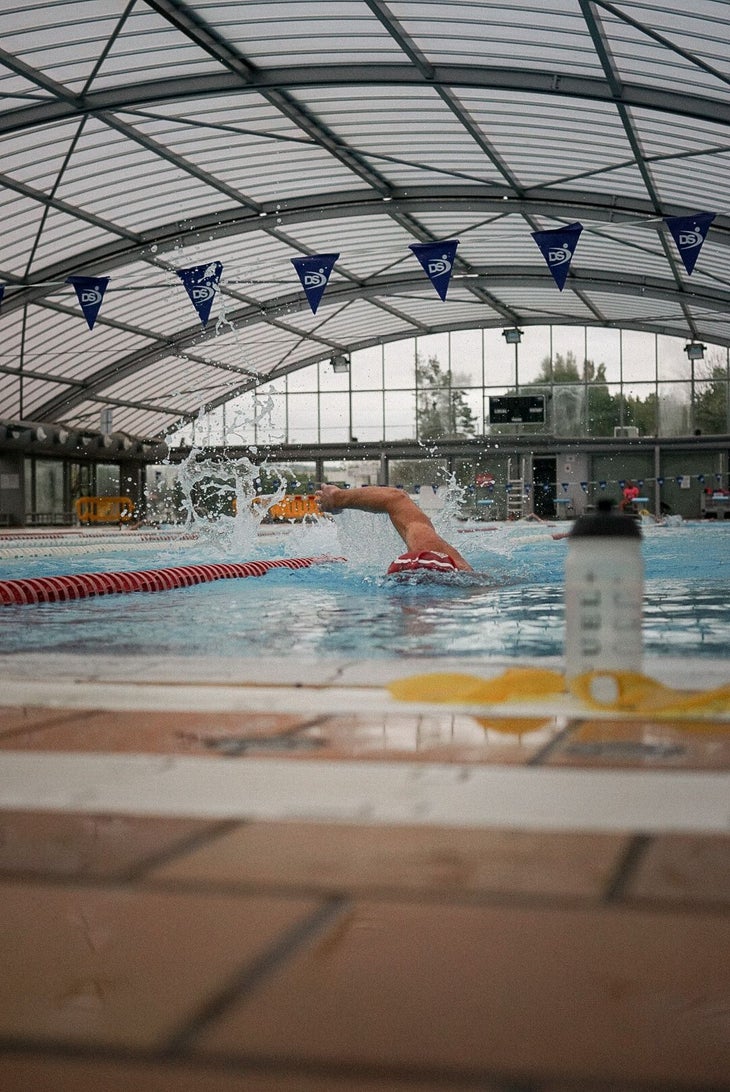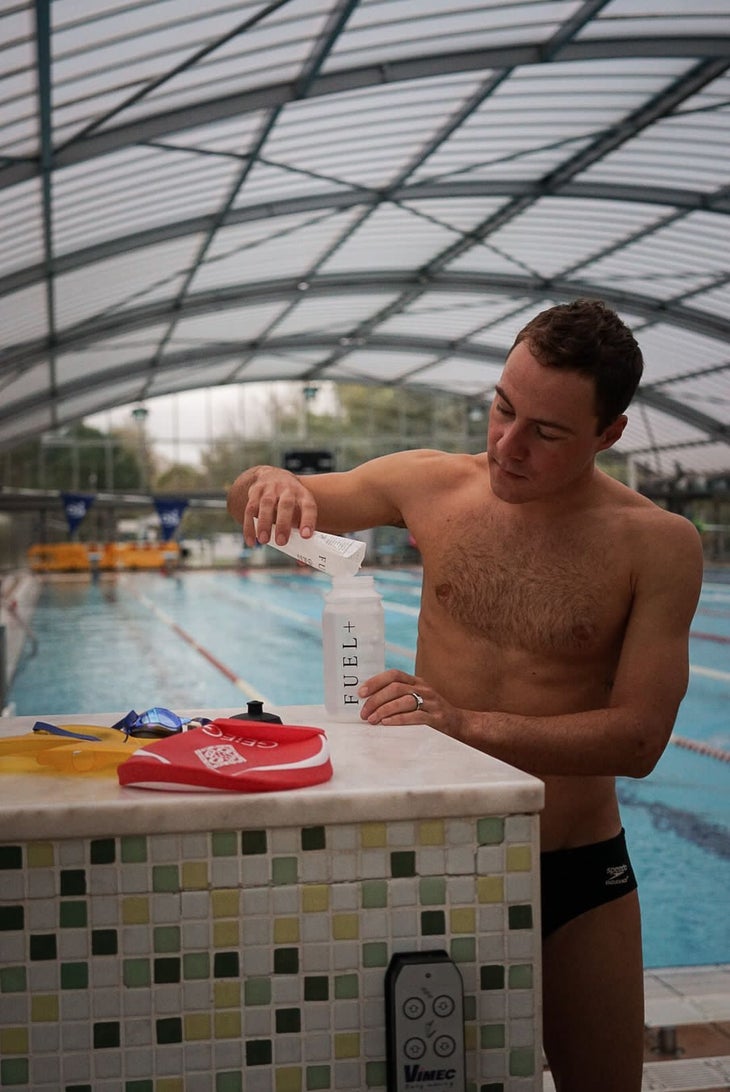New perk! Get after it with local recommendations just for you. Discover nearby events, routes out your door, and hidden gems when you sign up for the Local Running Drop.
Train 360 is our latest training column, designed to give you a deeper look at the many different aspects that go into a professional athlete executing a key workout. A key workout is considered a session that will yield significant fitness gains and is often positioned in a training program so that the athlete can hit it feeling relatively fresh and able to give it their all. As well as the key workout (which is listed in full below), there are many other factors to consider, including: “primer” sessions in the days leading in, activation and mobility exercises beforehand, fueling and nutrition (both before, during, and after the workout), mental preparation, and all of the gear and equipment involved. We’ve got it all outlined below from Collin Chartier as he gives us the insider info on one of his go-to swim workouts, an aerobic strength set.
If you’d also like to check out the previous features in the Train 360 series, we looked at the long run of Kona runner-up Ben Hoffman, the FTP bike session of three-time Ironman world champion Mirinda Carfrae as well as Mel McQuaid’s “Aerobic Sandwich” bike session.
The Purpose
“The objective of this workout is to get a high aerobic stimulus without going over lactate threshold,” Chartier said. “The first three-quarters of the main set should feel manageable; the latter portion at the same speed as all the others should start to feel challenging. If you are pushing the pace too fast in the early stages of this workouts, then you will miss the purpose of the workout. The key to this workout is about learning how to pace with even splits from beginning to end.”
Chartier emphasized that the 7-10 x 300 should not be done as best average or on the fastest interval you can go, but it’s more about hitting the right intensity consistently—and therein lies the challenge of this main set. Each 300 should be swum at around RPE (Rate of Perceived Exertion) 6/10.
He said: “Let the accumulation of the moderate intensity build on itself. If, for example, you swim 3:30 for the first five 300s and it feels challenging, and then you can only swim 3:40 for the remaining 300s (for the same RPE), then the 3:30 time was too fast to begin with.”
The Workout
Warm-up
600 swim (mix in a few 50s backstroke)
Take a few minutes to stretch your lats, triceps, and open up your shoulders
400 as 50 drill/50 swim
Suggested drills:
#1 – right single arm, with left arm straight out front + strong kick
#2 – left single arm, with right arm straight out front + strong kick
#3 – focus on underwater pull, breathing every third stroke
#4 – slow motion head tap (tapping your head with your hand as you recover your arm), breathing every third stroke, two-beat kick
8 x 50 on 50 sec. as 25 build to max/25 recovery
Note: If 50 seconds is too tight a turnaround here, simply take 15 sec. rest after each 50
100 easy
Main set
7-10 x 300 on 20 sec. rest @ RPE 6/10
4 x 50 on 60 sec. as 25 build to max/25 recovery
Note: If 60 seconds is too tight a turnaround here, simply take 15 sec. rest after each 50
Cool-down
200 easy

The Day Before
“I swim five or six days a week and the day before this set I will typically do 4-5K of easy aerobic swimming including a small set of sprints, like two rounds of 8 x 25 build to sprint + 25 easy. This is enough to stimulate the anaerobic system without causing excessive fatigue for the next day.”
When it comes to biking and running, Chartier said he avoids doing anything high intensity the day before in order to hit this swim workout without too much fatigue.
He added: “If the swim workout is the main workout of the day, I do it first thing in the morning then I’ll follow it up with a bike and run later in the day.”
Gear
“This workout doesn’t require any special gear. Just goggles, cap, Speedo, and a pace clock or watch. This is intentional because in a race we don’t get to use fins or paddles.”
Fuel
“This is the one swim workout during which I’ll use fuel,” he said. “I use a bottle with a Maurten 320 mix. And I have a Maurten 100/100 gel by the side of the pool in case I want it.”
Chartier said fueling for this workout helps him achieve two things:
1. It prolongs the number of repetitions he can do without slowing down or hitting the muscular fatigue point;
2. It provides a quicker recovery because it reduces muscle breakdown during the workout.
He said: “After this swim I don’t eat anything special, just a balanced meal with plenty of protein, carbs, and good fats that help prepare me for my next sessions.”

Mental Focus Points
“I would suggest not getting too excited or anxious for this set,” Chartier said. “It is not a test set or a best average set. Some days your paces will be slower at the same intensity and some days faster. Do not try to force the pace. It shouldn’t feel easy and at the same time it shouldn’t feel like you are at your maximum. The trickiest part of this set is finding the right intensity, so you end up building fatigue in the last few repetitions, and ideally completing eight to 10 repetitions.”
Pre-Workout Activations
Chartier said he likes to foam roll his back and sides beforehand to help get some more range of motion in his swim stroke. “I also do a few arm swings to loosen up the shoulders,” he said.
How to Expedite Recovery
“The key to expediting recovery is by swimming this set at the right intensity,” Chartier said. “If done right, it should take one to two days to feel like your arms have recovered. If you are sore or feel really tired in the water for more than three or four days then you may have done the workout too hard.”
Coaching Points and Tips
Chartier is self-coached and said he’s done this workout enough times to know how to get it right: “To decide on how many repetitions to do, you should pay attention to the muscular fatigue,” he said. “Once your form begins to break down, you can end the workout after the next repetition. You want the stimulus but not the excessive fatigue that comes with pushing through exhaustion.”
With that in mind, he said he isn’t afraid to pull the plug on this session if he gets in the water and finds he’s not feeling it—and he advises you do the same: “If you feel terrible in the warm-up and really aren’t looking forward to executing the main set, then shut it down and save the workout for the following day.”
